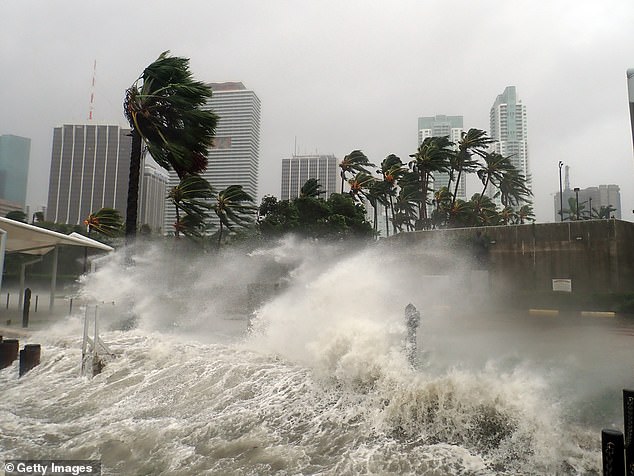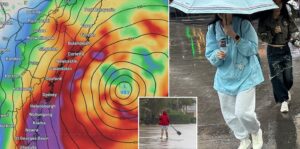
Forecasters are tracking a large weather disturbance forming near Florida that could disrupt July Fourth holiday plans for millions.
The disturbance has the potential to develop into a tropical or subtropical storm by the end of the week — as of today, the National Hurricane Center (NHC) put those odds at about 20 percent.
Even if the system doesn’t develop into a named storm, the NHC warns it could still bring heavy rainfall, gusty winds, dangerous surf, and life-threatening rip currents to the southeastern and eastern US.
It is estimated that a record 72.2 million Americans will travel for the holiday, due in part to the holiday falling on a Friday, creating a three-day weekend.
Weather forecasters warn the states that could bare the brunt of the bad weather are Florida, Georgia, Alabama, Mississippi, and the Carolinas, home to more than 39m people.
Coastal communities from Apalachee Bay and Big Bend to Tampa Bay are especially vulnerable, forecasters said.
‘More tropical trouble possible in the Gulf this week,’ said Meteorologist Zack Shields. ‘Not impacting Texas because the tropical disturbance is heading for Florida.’
Locals and holiday travelers heading to the beaches are being urged to stay alert, as rough surf, dangerous rip currents and gusty winds are possible, especially if the system strengthens into a tropical depression or storm.

Forecasters are tracking a large weather disturbance forming near Florida that could disrupt July Fourth holiday plans for millions across the Southeast (STOCK)

The system, still in its early stages, has the potential to develop into a tropical or subtropical storm by the end of the week
Warm ocean waters and low wind shear, conditions that help storm clouds organize, are creating a favorable environment for tropical formation.
While the odds of full development remain modest, forecasters warn that even a weak or slow-moving system could bring significant impacts to the region.
Meteorologist Chris Sowers said the area could see multiple inches of rain between Wednesday and Sunday.
In the National Weather Service’s Tallahassee region, daily rain chances exceed 85 percent through Wednesday, July 2.
Further south along the coast, rainfall totals could reach double digits in the coming days. The heaviest rain is expected on Thursday, July 3.
Rough weather is expected to arrive by midweek and linger through the holiday weekend.
The system currently stretches from the northeastern Gulf of Mexico across the Florida Peninsula and into the Atlantic waters off the Southeast coast.
The disturbance being tracked is referred to as a tropical cyclone in meteorological terms. This is a rotating system of organized clouds and thunderstorms that forms over warm ocean water with a closed circulation at the surface.

As of 8am ET Monday, the National Hurricane Center (NHC) gave it a 20 percent chance of development over the next seven days

The NHC and Florida Emergency Management officials warn that even without full storm formation, the system could bring locally heavy rainfall, gusty winds, rough surf, and life-threatening rip currents.
If wind speeds increase, it may become a tropical depression, then a tropical storm, and possibly a hurricane.
The NHC only assigns names to storms once they reach tropical storm status with sustained winds of at least 39 mph.
Currently, this potential storm has no name. If it intensifies, it will be named Chantal, following Tropical Storm Barry, which made landfall in Veracruz, Mexico on June 29 before weakening.
Despite the low odds of rapid development, the system is being monitored closely due to its proximity to land and the timing with the holiday travel peak.
‘This disturbance poses no direct threat to Florida over the next five to seven days,’ said the Florida Division of Emergency Management.
‘But could bring weather hazards along both the Gulf and Atlantic coasts.’
NOAA, the National Weather Service, and the NHC are using satellite tools and color-coded maps to signal tropical development risk: yellow for low, orange for medium, and red for high. This system is currently within the yellow zone.
‘If a system is near land and has the potential to develop, we won’t wait to issue advisories,’ said NHC Deputy Director Jamie Rhome.
‘This helps residents prepare.’
Meteorologist Jennifer Gray added, ‘Many Fourth of July barbecues, beach trips, and outdoor activities in the region may need a plan B.
‘Heavy rain looks likely as we head into the holiday weekend.’
So far, there are no tropical storm watches or warnings in effect.
But emergency services and forecasters advise residents to check local weather alerts and NHC advisories frequently.
The 2025 Atlantic hurricane season officially began on June 1 and runs through November 30.





